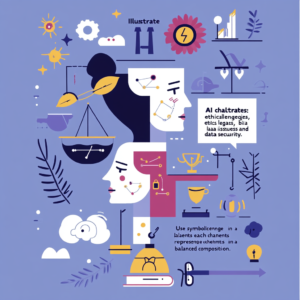
The Ethical, Collaborative, and Secure Future of PR with AI
The Dynamic Duo: PR and AI in Perfect Harmony—or a Recipe for Disaster?
Imagine, just for a moment, a world where public relations professionals wield artificial intelligence like an artist brushes paint onto a canvas—a masterful blend of creativity and technology. But don’t be fooled; this partnership has its share of ugly truths lurking beneath the shiny surface. The relationship between PR and AI could be an alluring serenade or a cacophony of ethical dilemmas, collaboration roadblocks, and data security nightmares. Buckle up, as we delve into this captivating union, exploring how to keep it on the right path while avoiding the pitfalls.
Ethical Considerations: Navigating the Grey Areas of AI
Now, diving straight into the moral maze, we find that ethics in the AI-driven PR landscape isn’t merely avoiding a lawsuit; it’s about safeguarding the trust of the public—and let’s face it, we all need a little trust nowadays. The ICCO Guidelines [1] drive home that transparency isn’t a luxury—it’s a necessity! For instance, when an AI churns out a press release, flagging that it was generated by a bot isn’t just polite; it’s ethical. PR professionals must play the role of ethical watchdogs, ensuring AI doesn’t perpetuate biases akin to a second-rate magician pulling the same tired rabbit from the hat. If AI fed with biased data makes decisions, it could not only fail to hit the mark but could hurt reputations faster than an ill-timed tweet.
Let’s tackle copyright issues head-on: the robot might regurgitate someone else’s content without batting an eyelash, risking infringement. It’s like inviting friends over to your house party but forgetting to ask if you could borrow their new record player (don’t take it lightly—music is life!). That’s why the ICCO guidelines remind us to double-check AI outputs for any potential copyright landmines [1]. Trust me, your legal team will sing hallelujah!
Collaboration: The Symbiotic Relationship Between Human and Machine
Alright, let’s get one thing straight: AI is not the enemy—it’s the wingman PR professionals never knew they needed. Imagine AI diving deep into data analytics while humans carry the torch with creativity and emotional intelligence. The PRSA Code of Ethics [5] emphasizes teamwork that transcends borders, where PR rebels team up with tech whizzes and ethical experts alike. Picture this: a crisis looms, AI crunches the sentiment numbers in lightning speed, and humans take the wheel, steering the message with empathy and cultural sensitivity. Now, that’s a tag team effort!
And let’s not forget media literacy—talk about an essential tool in today’s digital age! With AI generating content faster than coffee brews in a busy café, educating clients and stakeholders on what’s AI-made versus human-crafted is paramount. As highlighted in the ICCO guidelines, encouraging media literacy can be the first line of defense against misinformation and deepfakes [1]. Remember, folks, savvy consumers are informed consumers!
Best Practices for Ethical Collaboration
- Human Oversight Always: Experts should review AI-generated material for accuracy and relevancy. Don’t revive that old ghost of half-baked content! After all, the human touch is irreplaceable [1][3].
- Context is Key: Customize AI outputs to fit audience tastes, because one-size fits no one anymore [1].
- Transparent Client Communication: Keep clients in the know about how AI plays a role in their campaigns—trust is built on transparency, folks [1][5].
Data Security: The Unsung Hero of AI Collaboration
Ah, data security—the invisible shield that protects both brands and consumers. With AI’s knack for gobbling up big data, the stakes get sky-high. As highlighted by the OVIC resource [2], AI’s black-box decision-making can exacerbate biases and privacy risks. Consider this: training an AI on skewed data could lead to outputs that not only fail to resonate but may actually harm marginalized communities and businesses. Yikes!
But there’s hope! The PubMed Central article [4] points towards strategies like federated learning and differential privacy—no, they’re not fancy dance moves but rather smart ways of harnessing data without exposing the real McCoy. Implementing these measures means PR pros can utilize powerful AI tools while ensuring compliance with regulations like GDPR [4]. It’s a win-win for everyone!
Security Risks and Mitigation Strategies
- Copyright Conundrums: AI can be a plagiarism machine without proper checks. Verify what it spits out and always secure permissions for third-party content [1][3].
- Guard Against Breaches: Be careful not to feed sensitive client data into AI. Closed-loop systems are your new BFF for reducing data spillage [5].
- Combat Algorithmic Bias: Routine audits for discriminatory trends in AI outputs can save reputations. Collaborating with ethicists is key to tackling bias at its source [4].
The Future of PR & AI: A Dance of Balance
As technology evolves, so too must the PR industry’s mindset. The Prezly article [3] rightly cautions against leaning too hard on AI for creativity. Execution may be its strong suit, but strategy still needs a human’s delicate touch. Think of AI as the co-pilot, not the captain flying the plane.
Further emphasizing balance, the ICCO guidelines [1] advocate for responsible automation—streamlining efficiency without compromising ethical standards. This equilibrium ensures that PR remains a people-centered field, harnessing technology to amplify impact while retaining its humanity.
Want to stay up to date with the latest news on neural networks and automation? Subscribe to our Telegram channel: @ethicadvizor

